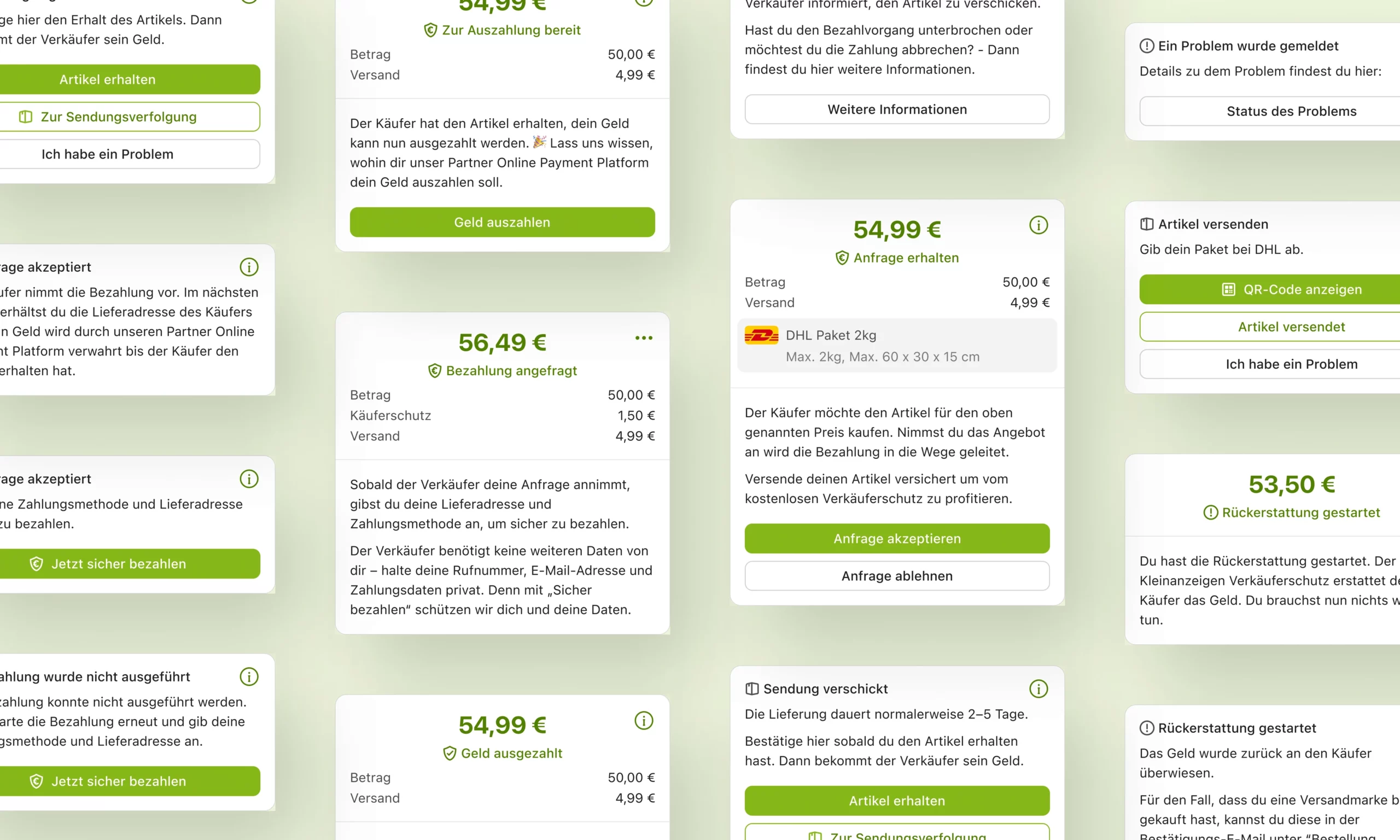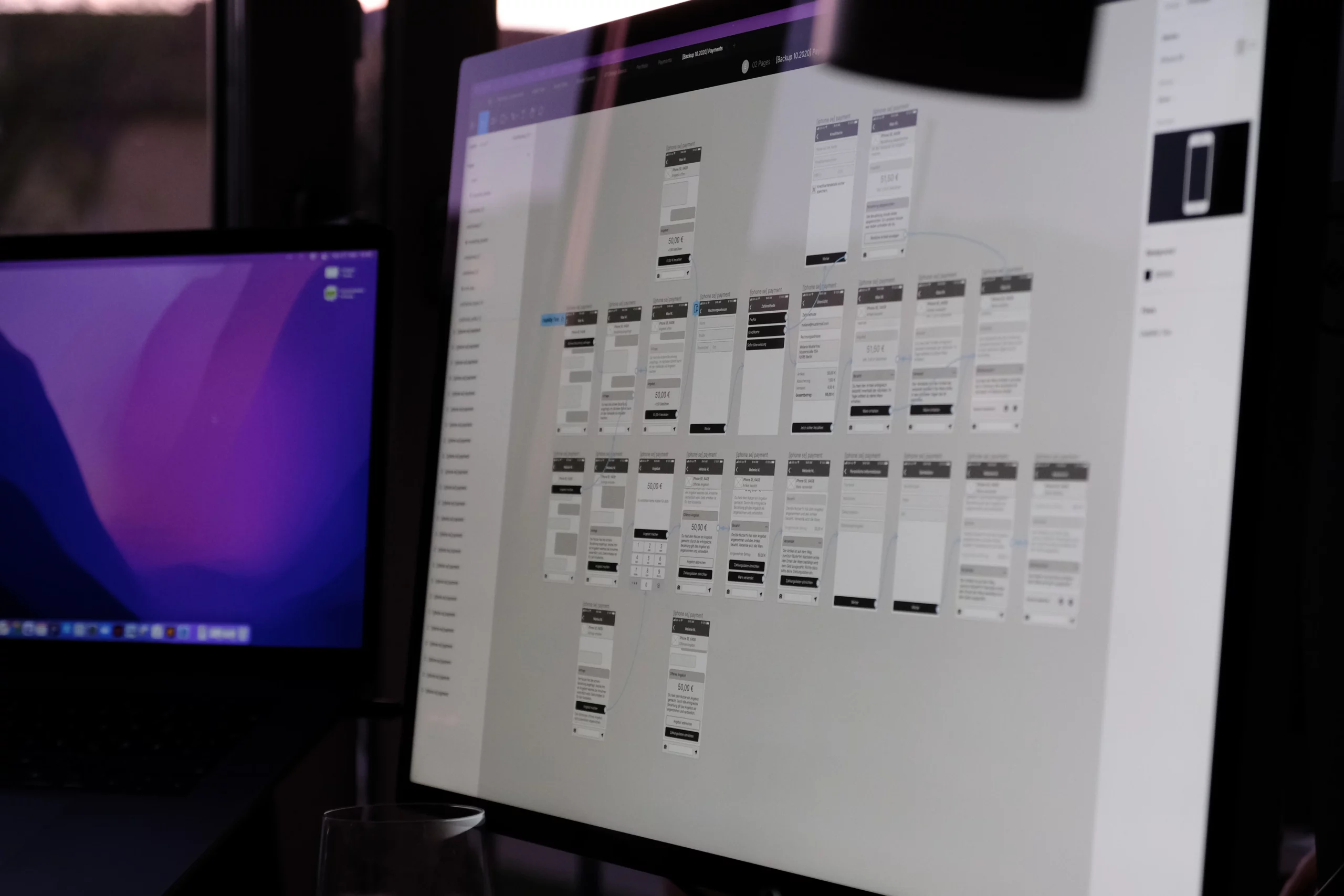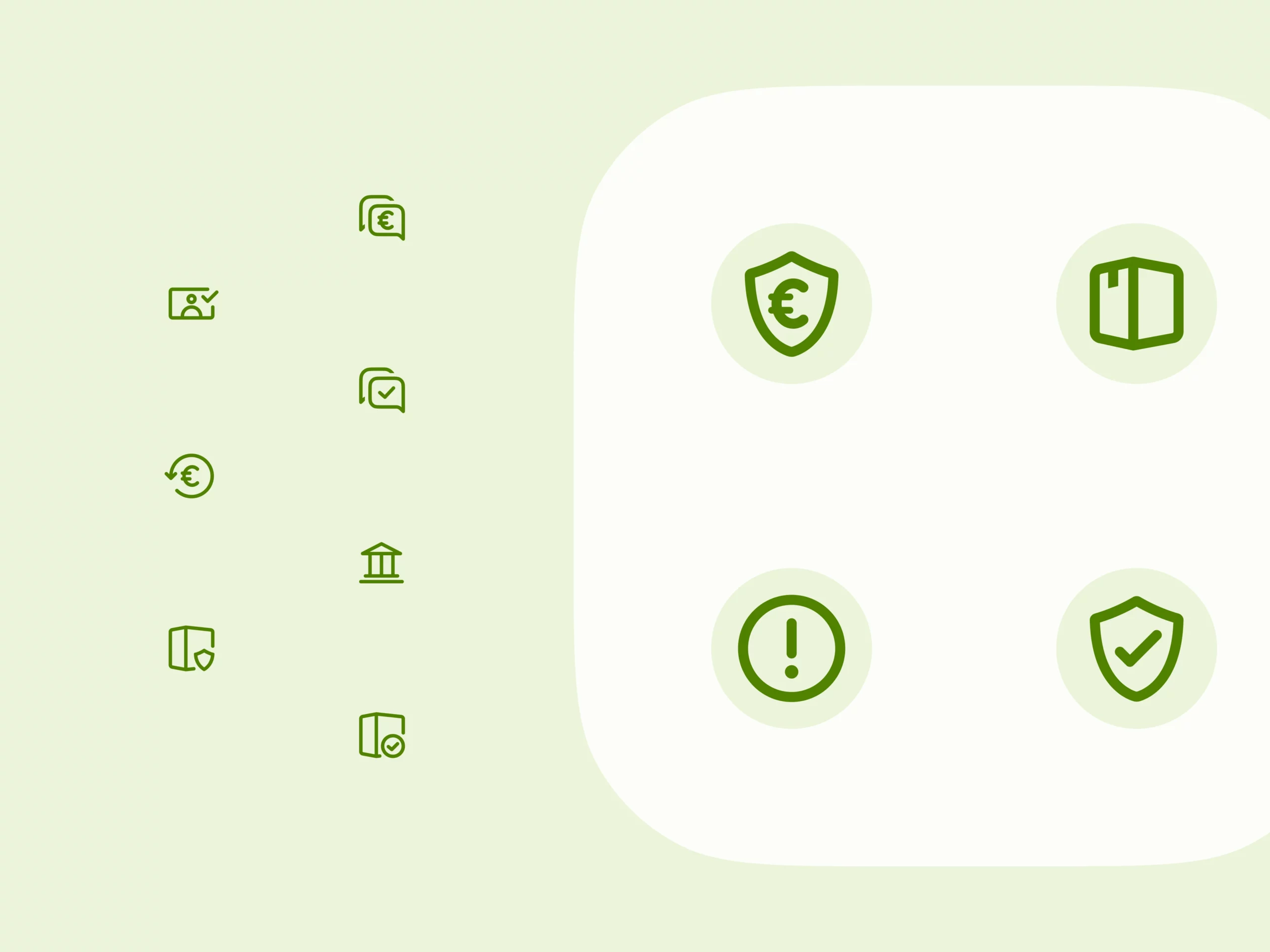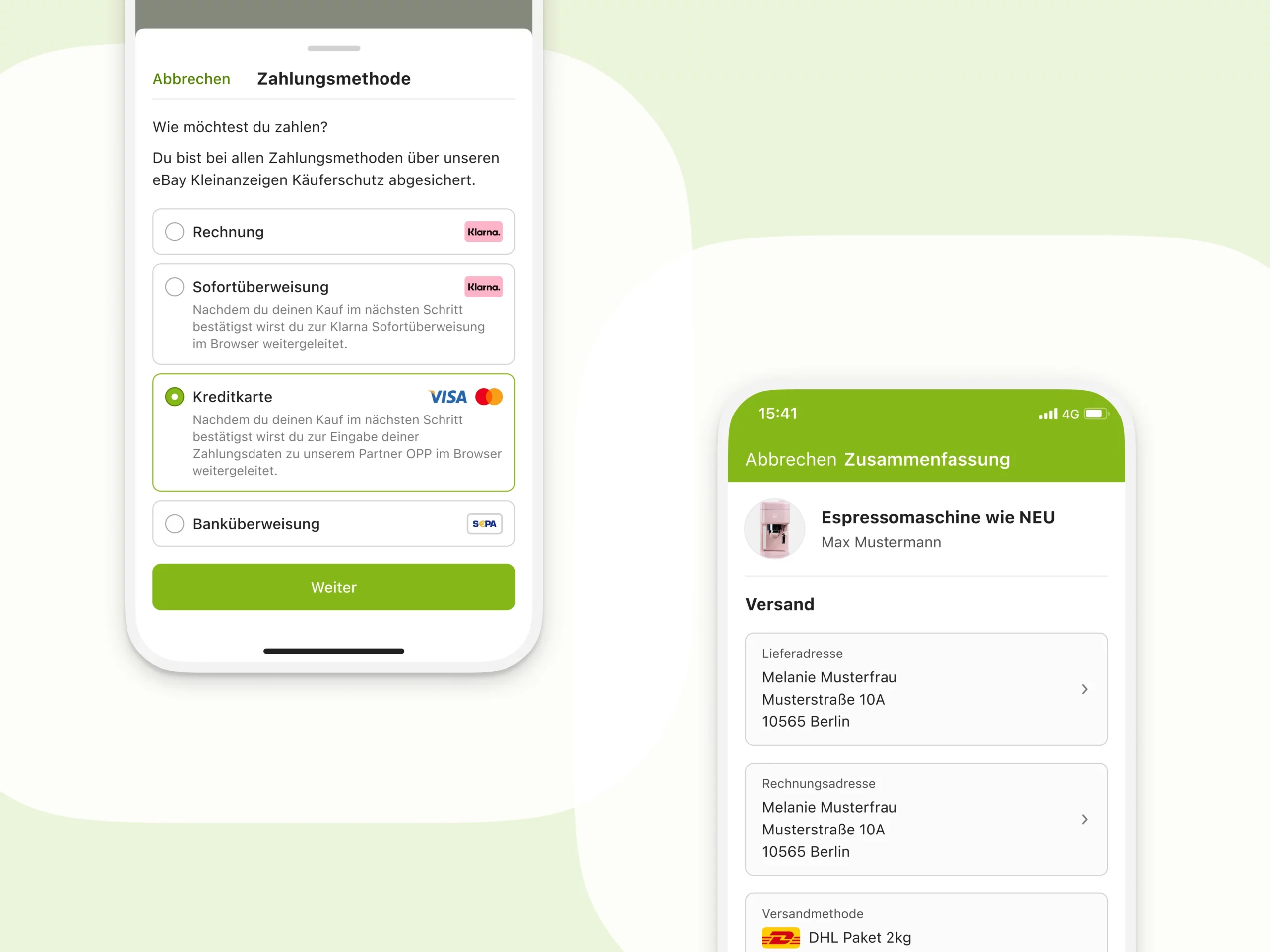Payments & Shipping
Role
Product Design & Strategy
Year
2020 – 2022
Client
Kleinanzeigen

With millions of ads posted each month, Kleinanzeigen is the biggest classifieds business in Germany. Items that have long been forgotten find a new home daily instead of collecting dust in the basement. For an item to find their perfect new home, the process usually goes something as follows: A seller posts an ad. Buyers search for an item and find what they are looking for. A buyer contacts the seller to show they are interested. The conversation goes a bit back and forth as they agree on a final price, shipping and maybe some additional information that wasn’t in the item description. The most important thing discussed in most cases is the matter of payment.
The Problem
With most transactions on Kleinanzeigen happening locally, one of the most given reasons why buyers aren’t considering items outside of their local reach is missing trust. Users are unsure if they will receive the actual item once they pay via PayPal or SEPA transfer.
Sellers often feel a missing commitment from buyers. In many cases sellers will chat with a potential buyer, commit to details but then never hear from the other side again. Sellers also have to manage the whole process themselves, agreeing on payment with the buyer, packing the item, picking a shipping provider, get a label, etc.
Hypothesis
We believe that by delivering a solution that is fair and heightens trust for both sides, we can improve the buying and selling experience for users, gain trust in the platform and create a business opportunity for Kleinanzeigen. We do that by opening up a much broader market to buyers and implementing a convenient payment solution that makes it easier to commit to a purchase. We reflect that commitment to sellers, leaving them in control of the process and the decision to accept. We take away the hassle of shipping, making it an integral part of the experience. Both sides show an equal level of commitment that results in buyers receiving their purchase and sellers receiving their money.
Research
For this project I worked together with internal researchers as well as external research agencies on multiple research projects.
Concept Test
After creating our initial concepts for the feature we looked to prove our assumptions with a concept test. We set up two different concepts to be tested:
Direct Payment
A buyer would offer money to the seller, the seller could accept or decline the offer. If the seller accepted the buyer would pay the agreed-on amount and the seller would receive the money directly. The seller would then ship the desired item.
Escrow
A buyer would offer money to the seller, the seller again can accept or decline. If accepted, the buyer pays money into a middle account, the escrow account. The seller is notified that the money has been “parked”. Sellers then send the item to the buyer via trackable shipment and buyers confirm receiving the correct item, which will trigger payout.
Findings
The direct payment flow was as close to current behaviours on the platform as it could get, but fell short at providing security and assurance for buyers.
Escrow was much appreciated among users, providing huge security benefits towards buyers. Although sellers were hesitant towards the late payout, users were also able to see upsides in commitment and peace of mind, knowing Kleinanzeigen would help out if something didn’t go as planned.
Wireframes
Once our initial research had concluded, product management and I decided to move forward with the escrow flow. I created a few first drafts in the form of wireframes. We wanted to keep the experience users know, keeping things inside of the chat interface to meet our users where they are. I established a pattern of „system messages“, messages being present in the chat when they become relevant, fitting right into the conversation while belonging clearly to the platform instead of the other side. An offer functionality was established, letting buyers make an offer to sellers for the agreed upon price. We decided to keep implementation efforts low on the payment process itself, wanting to learn fast and iterate from real user feedback. For our initial launch, buyers were only able to provide one shipping address when making a payment instead of implementing a full address book.

Usability Tests
The very first usability test for the feature was conducted in a coffee house in Potsdam, asking people if they would like to participate in our research and presenting them with printed out wireframes. We presented participants with different wireframes and flows and gathered many insights to iterate further on the design. We paid special attention to how sellers react to initially needing to setup their bank account. We realized that this being a key flow and a major hurdle for sellers needed „a little more love“, which led us to implementing it natively shortly after initially launching.
Design
I established key interface elements for the payment feature. System messages include all relevant information for users at the right time. They furthermore provide the most important actions, guiding the user automatically throughout the flow.
A status bar was introduced to give buyers and sellers an idea of where in the flow they currently are and what is coming up next. Especially sellers are eager to find out when they can expect their money.

I designed a payment-specific iconset, ensuring users recognize the feature across the Kleinanzeigen app and the flow stays consistent. The shield used for the „Send Money“ icon communicates trust and safety and is used across product and marketing campaigns.

We used bottom sheets at confirmation steps of the flow to make it easier for users to focus on important decisions while staying in context.
Key Learnings & Improvements
One of the first things we learned is that our initial placement of the offer process wasn‘t benefitial enough for buyers and sellers at the right time. Buyers often first interacted with the payment feature after purchase agreements were already committed between the two parties. This creates an additional step in the process, buyers having to send an offer with the agreed upon price to the seller, them first having to accept it before the buyer can make the payment. The product manager and I created an alternative flow that connected offer and payment. Buyers could send money, sellers then accepting the amount that was already parked on the escrow account. This flow ultimately evolved into a feature called „Buy Now“, detailed below.
Initially setting up their bank account for payout and verifying their identity is the biggest hurdle for sellers, them not seeing enough convenience. We want to heighten that convenience by learning from user feedback. One of the key points of hesitation for sellers is that they find the back and forth with uncommitted buyers as a waste of time. We want to reduce that painpoint by offering sellers a direct purchase option on their items. Buyers interested in an item that have made their purchasing decision based on the set price and initial description can buy it instantly. This eliminates the hassle for sellers, they now only have to hand the shipping box over to their selected shipping operator. This concept is currently being researched and explored.
Placing all main interaction elements inside of the chat turned out to miss opportunities for users to understand the payment flow and feel informed about their current state in the process. We want to make sure users trust the payment experience and understand what is happening at all times. This led us to iterate on major UI elements established for the payment flow, like:
Status Bar
Reducing the amounts of elements presented at a time to one and concentrating on what is currently important should make it easy for users to concentrate only on what is relevant in the moment.
Status Page
We want to create a central place for a payment in the users journey. This overview will evolve from the current status page, providing relevant information that updates over the course of the flow. For buyers, this means providing shipping as well as payment details and a more consistent progress indicator for the transaction. Building out the status page like this and presenting actions that are important in the moment takes away reliance on the chat for the payment flow, presenting a well known experience taking cues from traditional e-commerce platforms.
